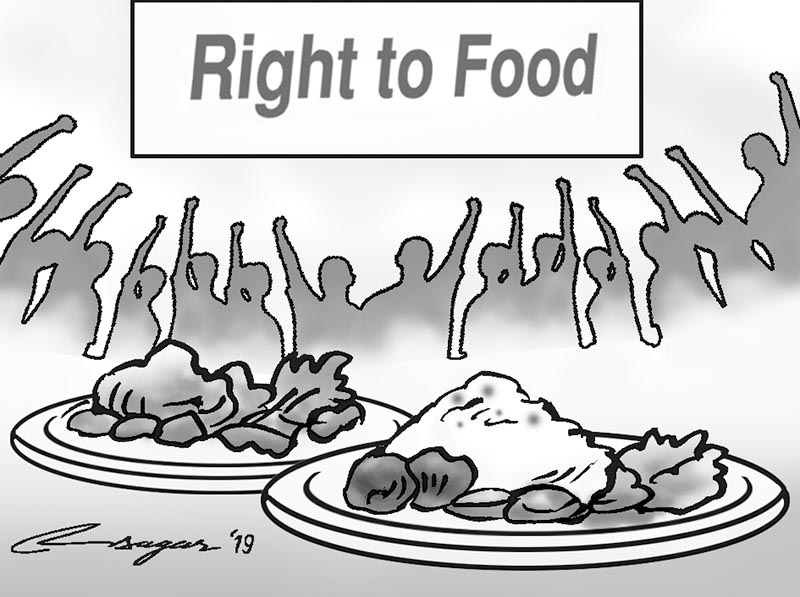Eradicating hunger: Possible in Nepal
RtF does not mean that individuals and groups have the right to be provided with food. It means that one has the right to feed oneself in dignity, through economic and other activities. The state has an important role to play in these efforts
The human Right to adequate Food (RtF) is of crucial importance for the enjoyment of all rights. It is mentioned in the Universal Declaration of Human Rights (UDHR 1948) and enshrined in the International Covenant on Economic Social and Cultural Rights (IESCR 1966), which was ratified in 1976. According to the IESCR, the right to adequate food is realised when every man, woman and child alone or in the community with others have the physical and economic access at all times to adequate food or means for its procurement. Nepal is also a signatory to the covenant.
RtF as a fundamental right has been explicitly mentioned in the Constitution of Federal Nepal, promulgated in 2015. Article 36 (3) of the Constitution has mentioned right to food and food sovereignty as fundamental rights of the people living in Nepal. By recognising RtF as a fundamental right, Nepal has become the fourth country in the world, after Bolivia, Ecuador and Venezuela, to mention RtF in the constitution.
RtF does not mean that individuals and groups have the right to be provided with food. It means that one has the right to feed oneself in dignity, through economic and other activities. In other words, individuals and groups are responsible for undertaking activities that enable them to have access to food. Nonetheless, the state has an important role to play in supporting these efforts.
For a poor country like Nepal, the government faces multiple challenges in fulfilling RtF. It has committed itself to achieving the sustainable development goals (SDGs) by 2030 and has also launched the Zero Hunger Challenge initiative while also developing the National Action plan 2016-25 that aims to end hunger by 2025.
These are some of the ambitious commitments Nepal has made, but it is going to be a herculean task for the country, considering the bleak picture of food security confronting it.
The number of food insecure people was estimated to be 2.2 million in 2016. Only 25% of the cultivated land in Nepal has irrigation. Most of the farmers are poor and cannot afford modern inputs, techniques and machinery.
Migration of youth to other countries in search of employment has led to feminisation of agriculture. A woman is burdened with both household chores and agriculture production. The number of people suffering from food insecurity and hunger is higher in the high hills and mountain areas. The western region of Nepal has the highest prevalence of food insecurity, with 76% of Nepal’s food insecure population living in this region.
Nepal is ranked 72nd out of 118 countries in the Global Hunger Index. As per the Global Food Security Index, Nepal is ranked 82nd among 113 countries, which shows a bleak food security situation in the country.
According to the Economic Survey of 2017-18, the country suffers from a food deficit of 71,400 tons.
Though the challenges are many and herculean, the state can work to fulfill its commitment. The state has three obligations to ensure the RtF of its people, namely Obligation to Respect, Protect and Fulfill. With the promulgation of the new constitution, Nepal aspires to rise from the status of a Least Developed Country to a middle income country by 2030, with the spirit of a welfare state with low vulnerability and high human security.
Hence, it is of paramount importance that food production be increased to end hunger. For this to happen, the food security and sovereignty policy should evolve as a basic element of the social security policy. Livelihood opportunities should be diversified and promoted as a coping strategy for food insecurity.
Sensible investment in the agriculture sector to boost the production and attract the youth towards agriculture should be done, which will enable the country to become self-reliant in agriculture production in the long run.
Growing enough food for the future generation will be a challenge without looking towards climate change and resorting to climate smart agriculture technologies.
It is difficult to increase the area of agricultural land, so agricultural productivity must increase through investment in climate smart agriculture and farm mechanisation.
The area under irrigation should be expanded, which will further improve agricultural productivity. Access to finance and market linkage of the farmers as well as extension services for the farmers should be improved.
Most farmers are small landholders and poor, hence access to finance will enable them to buy improved agricultural equipment and tools to increase production.
Linkage with the market will provide them a platform to sell their products, fetching them the much needed income.
Civil society can play an important role in putting pressure on the government. They can also assist vulnerable groups in sensitising and empowering them to claim their rights. Participation of poor vulnerable groups and farmers in social activities and linking them through networks will provide a strong safety net.
Now that Nepal has been federally restructured, there is scope to ensure right to food and eradicate hunger particularly because the constitution has assigned the role of primary intervention in the agriculture sector and food security to the local level government.






